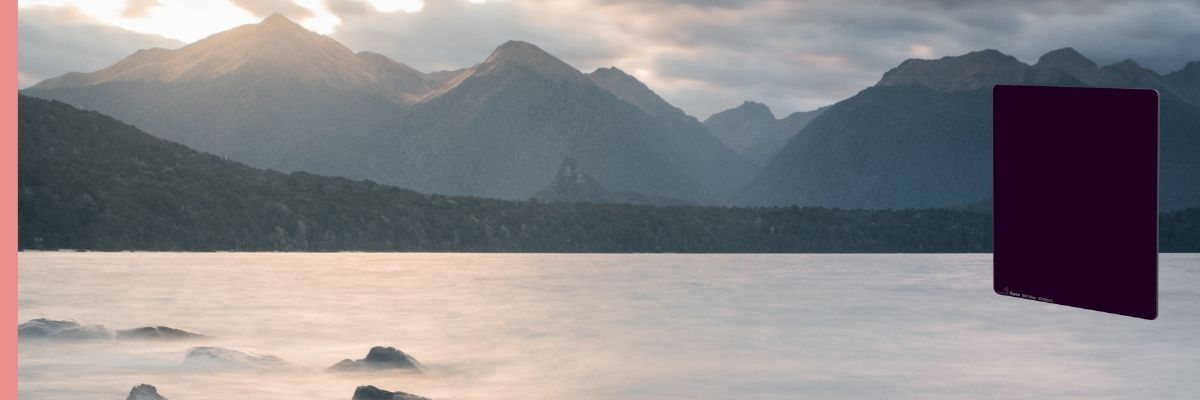
Our ND filter Wolverine K150 SLIM series from Kase
The Kase Wolverine K150 Neutral Density Filters are perfect for adjusting the amount of light that penetrates the camera sensor. Due to the longer exposure times, for example, the movements of the clouds can be captured or water can be drawn silky smooth. Due to the different strengths, graded in ND8, ND16, ND64 and ND1000, there is the right filter for you for every situation. Below you will find a table and a recommendation in which situation which filter should be used and what effect this has on the exposure time.
The Kase filters score with an outstanding color neutrality. This is supported, among other things, by the optical glass used, which is also extremely shockproof. In addition, our filters have an oil and water-repellent coating and are therefore very easy to clean. If you do not yet have a suitable filter holder for your lens, you can find one in our kits or in the filter holder category.
What does an ND filter do and where is it used?
An ND filter or neutral density filter is screwed or plugged in front of the lens to weaken the light falling on the camera sensor. The functional principle can be compared to that of sunglasses. Because if you look directly at the sun with the naked eye, you are blinded after a short moment and only see white. A camera sensor can also be "dazzled" and is comparable to the iris. This overexposes the image and may make it unusable as a result. ND means "neutral density" or in English "neutral-density".
The gray filters available from us are often used in landscape photography when long exposure is advantageous. For example, the filter can be used when recording a lake where you want to achieve a smoothing effect, or with bodies of water such as a river or a waterfall. However, the ND filter is also essential when the exposure cannot be long enough without the image being overexposed, despite the correctly set f-number.
An ND filter can also be useful in portrait photography with a relatively open aperture (blurred background) and a relatively short exposure time. Even when taking pictures outdoors in the morning or in the evening when the sun is low in the sky, the light falling on the sensor can be too strong. An ND filter then makes it possible to take a picture against the sun. In general, it is always worth having at least one gray filter with you if you want to take pictures in good weather.
Why should you increase the exposure time at all?
To summarize: To simplify complex scenes (e.g. in landscape photography).
Images that appear unreal can be created that the human eye could never perceive in this way, in that movements are displayed "fluently" through long-term exposure during the day. This makes the surfaces appear soft and smooth.
Other areas of application are also conceivable, for example larger aperture openings in daylight in order to achieve a shallower depth of field for landscape shots or portraits.
Moving objects are also filtered out by ND filters the longer the exposure time is selected. This can be used to remove people in front of buildings without post-editing in long exposures and architectural photography.
What else do I need for photography with a gray filter?
The same rules apply to long-term exposures with ND filters as to other long-term exposures.
You absolutely need a tripod for recording with a gray filter. Depending on the focal length, it is not possible for most people to shoot directly from the hand with exposure times of 1/40 seconds or more without blurring the picture. It is sometimes still possible for professionals to take photos of up to 1/20 seconds without a tripod, but from exposure times of around one second and more, this is also the end of it for professionals. A remote shutter release is also a great advantage. Because even when you pull the trigger, the image can already blur. Alternatively, the self-timer on the camera will do the trick.
How do I choose the right exposure time for a gray filter?
As already explained, the strength of the neutral density filter is directly linked to the length of the exposure time. With an ND8 filter, the exposure time is 8x longer. For example, if the camera's automatic mode specifies 1/20 second as the correct exposure time, an ND1000 gray filter results in an exposure of 50 seconds.
Aperture priority or aperture priority can also be used. The photographer determines the aperture and the camera automatically calculates the appropriate exposure time. In most cases, modern cameras produce a very good result. For an architectural or landscape photo, you should generally set an aperture value between 9 and 11 in order to achieve a high depth of field.
So if you want to take pictures with an ND filter, you should have setting options for shutter speed, ISO and aperture. This means that you should shoot in manual mode.
Which ND filter strengths to buy and when to use with the camera?
In photography, three different filter strengths are generally used. These are ND8, ND16, ND64 and ND1000 filters. The ND8 filter darkens 3 stops, the ND16 filter 4 stops, the ND64 filter 6 stops and the ND1000 10 stops. In general, it can be assumed that the exposure time doubles for each f-stop. This means that the ND8 filter causes eight times the exposure time and the ND6 sixty-four times.
Table of the ND filters we offer
| Neutral Density | f-stops |
Shutter speed increase factor |
filter designation |
| 0,9 | 3 | 8x | ND8 |
| 1,2 | 4 | 16x | ND16 |
| 1,8 | 6 | 64x | ND64 |
| 3,0 | 10 | 1000x | ND1000 |
The different filters are designed to get the best possible shots in different situations and times of day. In addition to the gray filters, there are also so-called polarizing filters. These do not reduce the incidence of light, but serve to prevent reflections. Especially with green and blue color gradations, i.e. primarily in landscape photography, polarizing filters are often found.
In which situation is which neutral density filter used?
|
Filter |
Situation |
| ND8 Filter |
The ND8 filter is used on sunny days and when the sky is slightly cloudy. |
| ND64 Filter |
The ND64 filter is to be used for snowy landscapes on sunny days, reflective water surfaces or similar. |
| ND1000 Filter |
The ND1000 filter is mainly used in landscape photography to create blurred clouds and softened water. |
What tools do I need for long exposures?
When taking pictures of landscapes and buildings, a perfect picture is required so that the chosen subject cuts a good figure in the photo. In order to achieve this, proper photo equipment is mandatory. With longer exposure times, this definitely includes the following things:
- stable tripod
- Remote shutter or time shutter
- Exposure time correction table
Even when using the highest quality tripod, it can happen that the recording becomes blurred. However, this is usually not due to insufficient stability, but to the mirror flaps. In order to take the perfect picture, it is important to avoid even the slightest vibration. To achieve this, the mirror lock-up can be switched on on a SLR camera. When this is activated, the mirror of the camera is already folded up before the actual recording. The mirror will remain there for the time being. If the camera shutter button is then pressed, the shock from the mirror is already over. Only the "curtain" of the camera is opened in order to expose the image, which means that the mirror flap has no negative effect on the image.












